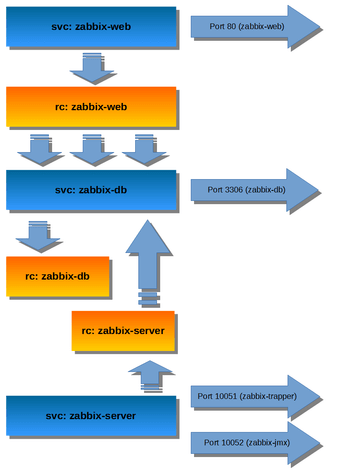Updated May 31, 2023
Definition of Kubernetes Zabbix
Zabbix is an open-source software that is used as a monitoring tool for the various IT components, which include could service, servers, virtual machines, network server, etc. Zabbix helps us to provide different types of metrics such as monitoring metrics, disk space consumption, and CPU load. For this, we require configuration in place, which can be done via XML templates, inside this XML we can define the components for which we want to do the monitoring. It is a web-based software with a centralized database, it also provides us visualization of our data which can be seen through the maps, graphs, screen, and overview, etc. In the coming section of the tutorial, we will see its internal working and implementation in detail to get a better idea about its working, for more clarity and understanding.
Kubernetes Zabbix Overviews
As we have seen, Zabbix is an open source software that is used for monitoring purposes; with the help of this, we can able to test various components of IT. It is a distributed monitoring solution, it helps us to keep track or monitor different parameters of the various IT components, which can include the network parameters, virtual machine, database, applications, cloud, websites, and many more components are there which can be easily monitored. Also, it helps us to generate alerts for any type of event which is helpful for the developers. Let’s list down the key points about Zabbix which can really be usable and make our applications more monitored easily which are as follows;
1) It helps in data visualization.
2) Monitor various It components.
3) Provide excellent reporting
4) detect problems serer very fast and quickly.
5) Help in the notification based on the events.
How to Use kubernetes Zabbix?
In this section, we will discuss the step-by-step process which will help us to use Zabbix in Kubernetes. It is a long process where we have to make sure about the file structure and set of commands which need to be executed in order to use Zabbix and setup it properly for monitoring purposes of our application. So let’s get started from very scratch to understand it better;
1) Kubernetes version used: v1.18.0
2) Steps to be followed:
a) In the first step try to create the namespace by using the below command;
kubectl apply -f namespace.yamlb) Once it is created, now we will be creating configmaps, execute the below command for this;
kubectl apply -f configmaps.yamlc) the Third step is to create the secrtetes .yaml file, by using the below command;
kubectl apply -f secretes.yamld) Once the .ymal file got created, now it is time to create the database, which can be carted using the below command;
kubectl apply -f database-mysql. yamle) In these steps we will create a Zabbix agent just after the database got created. Use the below command for this;
kubectl apply -f zabbix-agent.yamlf) Now the Zabbix server will be required, to run the below command;
kubectl apply -f zabbix-server.yamlg) This will be the last step to create the file structure, in this, we have to create the frontend .yaml file, by using the below command;
kubectl apply -f zabbix-frontend.yamlAt this point, we have now created all the files that are required. Now we will see the significance of each of the files in detail see below;
1) zabbix-frontend.yaml: This file is used for the frontend configuration.
2) zabbix-server.yaml: This file is used for the Zabbix server configuration.
3) database-mysql.yaml: This file is used for the Zabbix database configuration.
4) zabbix-agent.yaml: This file is used to configure Zabbix agent.
5) nampespace.yaml: This file is used for the namespace configuration.
6) confimaps.yaml: This file conation a general variable that is going to use in the various configuration files.
7) clusterRole-monitoring.yaml: This file contains roles.
8) cadvisor.yaml: This file helps us to get and export the monitoring metrics based on the data we have.
All these steps can be executed in the same order as they are written here.
Kubernetes Zabbix Service
Service here means Zabbix offered us service monitoring functionality which helps us to get a high level of monitoring. Sometimes it is required by the developers that they are really inserted to know the high-level details of the service, which includes all the serve’ provided by the IT department, and does not really care about the disk space, processor load, etc. Also this high-level monitored helps us to get the weak places for the IT infrastructure, the structure of existing IT, various It service SLA, and other information which will be at high-level. So by the use of the Zabbix service, we can easily track and monitor this high-level information that will be needed.
For service we have a basic structure which looks like below;
1) Service: which contain Workstations, Servers, etc. represented by the below structure;
Service
-Workstations
-Workstation1
-Workstation2
-Servers
Replication controller schema
In this section, we will be discussing the Replication controller schema in detail with a diagram to understand the flow of this as well, so let’s get started with the overview by the diagram see below the flow diagram to get a better understanding;
As we can see in the above diagram it consists of various types of components here. It helps us in the high availability of the monitoring, of the IT components. Here, the replication mechanism works by the use of binary and asynchronous. Works on the concept of nodes if we have multiple nodes, and the middle node is disabled when it will work on the first node and so on. It does not care about the disabled node, it will keep on working with the other nodes.
Conclusion
As we have seen the use of Zabbix which helps us to monitor various IT components without much hustle. It is recommended to go through the whole article for better clarity and understanding of it. It has all the steps to use this and configure it properly using sets of commands.
Recommended Articles
We hope that this EDUCBA information on “Kubernetes Zabbix” was beneficial to you. You can view EDUCBA’s recommended articles for more information.



